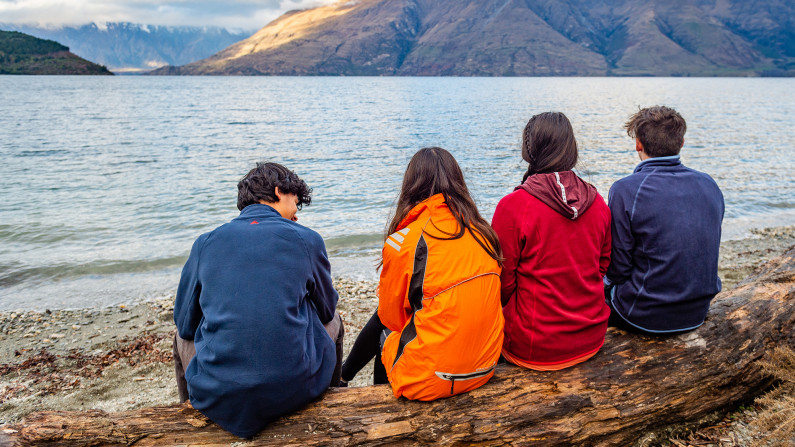Hiwa-i-te-rangi Future aspirations and actions to sustain the environment (te taiao)


E tū Hiwa-i-te-rangi e
Te kauwaka o te manako nui
Anei ngā tōmina o te ngākau
Hei whakatinanatanga mau
Behold Hiwa-i-te-rangi
The medium of my desires
You know for what I yearn
Make my dreams come true
Hiwa-i-te-rangi is the youngest child of Rehua and Matariki. ‘Hiwa’ means ‘vigorous of growth’ and ‘i te rangi’ means ‘in the sky’. Her role is distinct yet connected to those of her siblings in Te Kāhui o Matariki (the Matariki cluster). Her siblings are connected to specific environmental domains and provide signs (tohu) in relation to the environment (te taiao). The role of Hiwa-i-te-rangi is to shine (to pīata), and provide a light and motivation to step into the unknown. She helps us navigate these signs to move forward.
Hiwa-i-te-rangi represents our aspirations for a prosperous season ahead (Matamua, 2017). She is connected to looking forward: planning to succeed, hopes for future growth, and holding on to a prosperous vision of our future.
Our values and choices result in pressures on te taiao, including land-use change and intensification, invasive species, pollution, natural resource use, and climate change (see Pōhutukawa section). These pressures can result in the loss of ecosystems and species, and negatively impact on aspects of wellbeing, especially non-material aspects of wellbeing. These pressures can also leave a legacy, impacting the wellbeing of future generations.
In this section we look ahead to the complex and interconnected environmental challenges facing us and future generations, as well as our ability to adapt to and mitigate future risk.
Future greenhouse gas emissions from Aotearoa and the rest of the world will continue to drive climate change. However, even if emissions were brought to a halt, the greenhouse gases that have already accumulated in the atmosphere will have major impacts. Globally, it is estimated that by the end of the century average global temperatures will very likely be between 1 degree and 5.7 degrees Celsius warmer than pre-industrial temperatures (ie those recorded during 1850–1900). A sustained global surface temperature at or above 2.5 degrees Celsius higher than pre-industrial level is estimated to have occurred over 3 million years ago. Exactly how much warming we experience depends on the trajectory of our future emissions (IPCC, 2021).
We are already observing changes in our climate and experiencing their impacts (see Waipunarangi section). For Aotearoa, it is expected that our future climate will include higher temperatures across the country and a consequent increase in the number of warm days (defined as days with a maximum temperature of 25 degrees Celsius or higher). Rainfall patterns are also projected to change, generally with wetter areas getting wetter, drier areas becoming drier, and extreme rainfall events becoming more common in many areas (MfE & Stats NZ, 2020a). The combination of warmer temperatures and rainfall changes are projected to bring more severe and frequent droughts. Hotter, drier, and windier conditions are also expected to increase the days with high or very high extreme fire danger. By 2100, sea-surface temperatures are projected to increase between 1.1 and 2.5 degrees Celsius above the mean sea-surface temperature observed between 1976 and 2005, with major impacts on the marine environment (Law et al, 2018b).
Sea level is also rising with warming temperatures. The rate at which this will progress depends on future emissions and how fast polar ice sheets will change with rising temperatures (MfE & Stats NZ, 2020a). As sea levels continue to rise, low-lying areas will continue to be at risk of coastal inundations, with impacts on housing, infrastructure, and coastal ecosystems (see Waipunarangi section).
Our indigenous fauna and flora face many pressures including invasive species, habitat fragmentation, and intensive land use. Climate change is likely to exacerbate these. For instance, exotic plant species could be advantaged by warmer temperatures and more suitable conditions, displacing and outcompeting native species (Macinnis-Ng et al, 2021; PCE, 2021a).
Plant diseases which harm our native flora could also be advantaged. For instance, myrtle rust arrived in Aotearoa in 2017. This fungal disease reproduces in conditions of high humidity and warm temperatures. While temperature is currently the limiting factor, future scenarios of climate change indicate an increase in optimal conditions for infection and spread of myrtle rust across the country (Campbell et al, 2020). Climate change may also alter the distribution of wildlife diseases (Alley & Gartrell, 2019).
Other indirect climate impacts on ecosystems include increased vulnerability to erosion, coastal habitat squeeze (the loss of intertidal habitat due to sea-level rise and structures such as sea walls), severe fires, and changes in ocean productivity and food webs (IPCC, 2022b; Keegan et al, 2022; Lundquist et al, 2011; Macinnis-Ng et al, 2021; Parsons et al, 2020). We have limited knowledge on the direct impacts of recent climate change on biodiversity. The lack of data and long-term studies limit our ability to understand how Aotearoa species will be affected in the future (IPCC, 2022a; Law et al, 2018b; Macinnis-Ng et al, 2021).
Displacement of human populations due to weather-related disasters or rising sea levels may drive population changes and migration patterns (International Organization for Migration, 2021; Ning et al, 2018). Globally, changes in dietary preferences (such as increased meat consumption) and unequal crop yield changes will also likely drive changes in commodity prices and trade policies, affecting our agricultural sector (Ning et al, 2018; Renwick et al, 2016; Ritchie & Roser, 2017).
Changes in demographics is known to be one of the drivers of change for land demand and urban expansion (see Our land 2021). The population that resides in Aotearoa is expected to continue growing in the coming 50 years. However, projections indicate the speed of this growth will slow with time, and could eventually result in a population decline (Stats NZ, 2020). In addition, it is expected that the country will continue to move towards an ageing population structure where there is a growing proportion of the population in the older age brackets (Stats NZ, 2020).
Climate change will have major impacts on agriculture through rising temperatures and shifting rainfall patterns. Modelling using climate projections shows optimal locations for pasture production may shift. Overall yields are projected to stay relatively constant or could even increase due to climate change (Keller et al, 2021). However, these yields are estimated to be increasingly variable and unpredictable. The increase in carbon dioxide in the atmosphere is expected to help plants grow, through stimulating photosynthesis and water-use efficiency for pasture and pine forest, although the magnitude of the effect is uncertain (Keller et al, 2021; Kirschbaum et al, 2012).
Warming temperatures may pose serious risks for the health of livestock. This can be directly through heat stress (Ausseil et al, 2019), and indirectly through potential increases in existing diseases (such as facial eczema), and through more severe microbial and parasite infections (Lake et al, 2018). Warmer temperatures may be favourable to insect pests, increasing damage to crops and plantation forestry (MPI, 2015). Fire risk may also increase (Watt et al, 2019). Climate change represents a particular risk for Māori forestry, farming, and horticulture, as Māori land is often on erosion prone hill country already vulnerable to extreme events (Awatere et al, 2021).
Some adaptation measures are showing promise to counteract the effects of a warming climate. For instance, earlier sowing dates for maize can compensate and even increase production, and provide opportunities for longer winter growing seasons (Ausseil et al, 2019; Teixeira et al, 2020). New areas of Aotearoa will likely become suitable for vineyards due to a decrease in frosts, and a shift to other grape cultivars adapted to warmer and drier climates could bring new opportunities (Ausseil et al, 2021b). Some crops such as kiwifruit may need to shift location or use chemicals to induce fruiting (Tait et al, 2017).
The unpredictability of rainfall patterns will lead crops to depend more on irrigation to cope with future droughts. Climate change will affect the water cycle and hydrology, although large uncertainties remain on how climate change will impact water availability in different regions (Collins et al, 2018; IPCC, 2022b; MfE, 2020). Drinking water availability will also need to be assessed in conjunction with future demands from a growing population (Kamish et al, 2020). All these changes and demands will likely increase pressure on our freshwater environments.
Pests and diseases that can establish or spread more easily due to climate change are a risk to human health. Three quarters of new and emerging human infectious diseases are caused by pathogens of animal origin (Taylor et al, 2001). The emergence of these diseases from wildlife has increased over the past 80 years (Jones, 2008). This is mainly due to human impacts on land-use change and the wildlife trade that have exacerbated the likelihood of spill-over of pathogens into humans (Lawler et al, 2021). COVID-19 provides a recent example of this.
In Aotearoa, the risk of wildlife diseases jumping to humans due to climate and land-use change needs to be investigated further (Lal et al, 2015). Climate change, the age structure of our population, and anti-microbial resistance may also increase the risk to our population. An integrated approach such as OneHealth is needed to understand the interconnectedness and magnitude of these effects (PMCSA, 2021b).
The environmental challenges ahead are complex, interacting, and sometimes outside our direct control. Understanding how our wellbeing is interconnected with environmental change is necessary to ensure the health of the environment as well as that of future generations. It is therefore crucial to make sure we can measure and report on the changes happening in the environment.
Over the past three years the Parliamentary Commissioner for the Environment has released a series of reports that identify the need for systemic reform to better integrate the environment and intergenerational wellbeing into policy. These reports, viewed collectively, point to the fundamental role of environmental reporting [PDF, 7.2 MB] and environmental research [PDF, 3.1 MB] in building the environment and wellbeing [PDF, 2.1 MB] into decision-making and public expenditure. The recommendations in all three reports are being reflected in the Ministry for the Environment and Stats NZ’s work programmes, in particular the proposed amendments to the Environmental Reporting Act. Environment Aotearoa 2022 builds on the advances made in the last domain reports and takes us closer towards an improved system of environmental reporting.
Alongside the work to reform the Environmental Reporting Act, focus needs to be placed on building a fit-for-purpose environmental monitoring and reporting system that is adaptable to a rapidly changing future. Particular areas of focus include:
The purpose of environmental reporting is ‘to enable the evidence-based analysis and decision making needed to achieve effective stewardship of the environment’ (PCE, 2019). In Environment Aotearoa 2019, we summarised the purpose of the report as providing ‘evidence to enable an open and honest conversation about what we have, what we are at risk of losing, and where we can make changes’. This report presents a commentary, supported by Māori knowledge (mātauranga Māori), science, and indicator data, with this purpose in mind.
But this report is only the start of the journey. Hiwa-i-te-rangi invites us to reflect on these insights and to engage in conversations about our aspirations for the future. Environment Aotearoa 2022 will only serve its purpose if we as individuals, as whānau, and as communities think to the future and how we protect te taiao, our wellbeing, and the wellbeing of future generations.

Image: Clare Toia-Bailey, image-central.co.nz

Hiwa-i-te-rangi Future aspirations and actions to sustain the environment (te taiao)
April 2022
© Ministry for the Environment